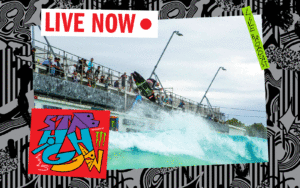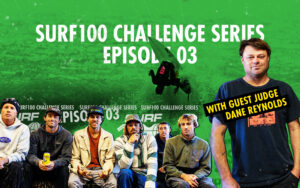Dane Reynolds: The Caricature Of The Vlog Identity, The Perils Of Business And Friends, And Surfing At Full Capacity
Five (recycled) highlights from our last Stab Unplugged.
Picking apart a podcast featuring Dane Reynolds is worthwhile from more than just a metrics perspective. While reader polls and analytics show Dane is one of the most sought after in surfing, he’s also one of the more insightful when it comes to interviews; particularly when that interview also contains three-time World Champ, Mick Fanning, and Stab’s founder, Sam McIntosh.
While podcasts are oft-best consumed in their entirety, not everyone has an hour-plus to pull out of their day to listen to surfing. I however, over this weekend, did. Yeah, you can make a five-minute cutdown of Dane talking about leaving Quiksilver and some teething problems in Former, but it’s hard to encapsulate the full extent of the interview in a short write up above a Soundcloud link. A a result, there’s many morsels that go astray for those of you who are time poor.
So, here’s five sections and accompanying quotes I thought worthy of being further divulged.

Dane Reynolds and Craig Anderson during Former’s, uhhhh, formative days.
Photography
Warren Smith
In late February 2017, Dane, Craig Anderson, and Austyn Gillette finally unveiled their new surf x skate brand, Former. After much hype in the months which followed Dane and Craig’s independent departures from Quiksilver, and the rumours as to their new brand, Former and its first range, Luxury 29.99 was live.
They had brand launches in Los Angeles, Sydney, and a Craig film project to boot. From the outside everything seemed golden. The next 12-plus months were however a reality check for the initial founders. With ideas in mind they hired a bunch of friends to help start their brand, but soon it dawned on them they had started more than just a brand: they had started a business. Things started to deteriorate from video premieres to friends arguing about tee-shirt designs, and eventually the realisation a lot of product had to be moved in order to keep their friends employed.
Less than two years since Former’s birth, Dane regained autonomy over the brand and being a self-confessed ‘control freak’ he moved the whole project into his Ventura garage. Dane was printing tees, replying to customer enquiries, and the realities of starting a clothing brand in a languishing surf-apparel industry were soon apparent.
When the Covid-19 pandemic struck, Dane worried it might be the end. But after a “few back-to-back good months” and assumptions that unemployment payments are being traded for Former merch, Dane says things are looking up.

On location in Mexico for the first Electric Acid Surfboard Test
Photography
Sam Moody
This one is a recount from Sam’s time editing the first Electric Acid Surfboard Test with Dane, a movie which Dane edited almost in its entirety. He didn’t just choose the tracks (which were all non-negotiables and cost upwards of $18,000 USD to licence), but he pieced together the clips and put all the finishing touches.
This approach to film editing though isn’t new to Dane. While Jason ‘Mini’ Blanchard filmed the majority of Dane’s Marine Layer videos, Dane edited almost all of it. Mini would send him something with a shitty track, or a few clips he wasn’t fond of and soon enough he took over the editing process himself. From that day to now (Dane is currently editing an Andrew ‘Droid’ Doheny video clip, stop motion animation included), he’s had control over the video sections he’s released. The most notable of which being Chapter 11, a movie which Sam believes is second only to Kelly Slater’s ‘Black and White’ in terms of surf films.
As Dane says, the programming for these editing programs is easy to use, but that does not account for the quality and end-product which typically results from a Dane-produced clip.
While he later assures Mick he would be “hands-off” if he were to do another team movie with the likes of Taylor Steele or Kai Neville, he admits it would be hard to completely let go.
The below video was in fact edited by Mini.
While often lauded as the world’s best surfer in and around 2010, Dane’s best ever placing on the World Tour was fourth and in that time he never placed better than second in a competition. In short, you could put this down to not being a great competitive surfer. But really it’s more to do with approach than actual competitive skill.
Dane never wanted to ‘safety surf’ a wave just to make a heat. If the opportunity for a big air presented itself, he’d go for it, and often this tactic resulted in heat losses. He traces back his love for this mentality to a comp in his grommet-hood where he didn’t win but he got a double page spread from a massive air he didn’t stick. Yeah winning the comp might’ve been nice, but he didn’t want to win knowing he could’ve surfed a wave better. Whether this mentality is a product of Dane’s time spent on trips where everyone is competing for the best clips and subsequent end-section, or whether it’s just an unwillingness to surf half-heartedly is unknown, but we wouldn’t have things like the ‘Dane turn’ at Haleiwa had it been any different.
Mick goes on to talk about other surfers like this. Some like Italo Ferreira and Gabriel Medina seemingly stomp everything they attempt so it doesn’t matter. But others like Julian Wilson, according to Mick, have their competitive results hindered by the “all or nothing” approach they take to competitive surfing.
For someone whose online site, Chapter 11 TV, could be referred to as a vlog, it might seem weird for Dane to says vlogs are the thing he hates most in surfing. It isn’t however the idea of putting a narrative driven surf-film online he dislikes, but the way which they’re done. Their goal is getting views, and while this end is often reached, it doesn’t always justify the means which got them there.
In Sam’s eyes they need to be dumbed down to achieve their metric goals, and in Dane’s, well they’re just “self indulgent”. They do however have a tonne of respect for the likes of Jamie O’Brien who manage to release two narrative-driven films a week, for free. On the contrary, the likes of Dane and Stab take months and countless emails to make the final adjustments to a nearly-complete film that’s only marginally longer than a JOB vlog—and often get less views.
The conversation then moves onto the world of surf films altogether. As groms, Dane and Mick, like many of us, had to fork out $20-plus dollars to buy the latest surf film and then watch it until the tape had burned out. Today though, there’s endless content being placed online – whether it’s YouTube, Vimeo, Instagram, or even Tik Tok – for people to get their surfing fix. There’s no doubt the quality has taken a hit, but the quantity has increased exponentially.
Both being strong believers in paying for quality products like this, Mick put to Dane that perhaps he could be the person to regenerate this trend. As Mick says, like actors often move into a directing role later in life, maybe Dane could follow the same path. And rather than throwing it online to receive 1 million clicks, maybe he could charge $20 or $30 bucks and have 10,000 purchases. There’s $300,000 to fund your next project you truly care about.
As an aside to media in general, a free press is one we all pay for. Ten years ago paying for your news and entertainment media was standard; whether that was a newspaper, buying a DVD, or in the surfing realm, a mag with a recent film attached. Today, a lot of this content is free. But there’s a downside to this. The money for this content has to come from somewhere, and if not from the readers, it comes from advertisers who often want a say in the content itself. In political news, advertisers often have a vested interest in whose in power and a result shift the news itself (just read Noam Chomsky’s Manufacturing Consent). This same concept, while maybe not as ‘important’, can be applied to surf media. If the market is unwilling to pay, don’t be surprised when your offerings are all one minute Instagram hits and you’re pining for the yesteryears of Taylor Steele and Kai Neville.
The late 2010’s was the golden era for surfing contracts. The ‘next big things’ like Dane Reynolds, Julian Wilson, and Kolohe Andino could all nail contracts which accumulated into the millions and nobody would bat an eye. And while the pandemic has dealt a further blow to the industry, these contracts had already long-expired.
For Dane and his peers the metrics were clear: get a section in a Steele or Neville film, get a spread in a magazine, place well in a comp, and keep your sponsor happy. Now, the playing field has completely changed, and there’s next to no money to be made anyway. In Stab’s 2018 Rich List John John Florence topped earnings with over $5,000,000 for one financial year. In five years time, it would be surprising to see anyone pocketing more than a million.
While no one knows what will work, Dane has some advice for today’s wannabe freesurfer:
“It’s more accessible than ever, you know, you can just put your own YouTube videos up. Unless you’re doing the most insane surfing in the world you have to figure out a way to tell your story uniquely. If you’re silly and you feel like doing pranks and stuff on camera, that might work for you. But it has to be genuine, whatever you do. You can’t try and develop a persona for the camera.
“Being genuine shines through. It’s glaringly obvious when someone tries to portray something they aren’t. For me, videos also need some purpose or context beyond, ‘look at me rip’.
“Oh, but high performance surfing is also essential. You gotta rip.”













Comments
Comments are a Stab Premium feature. Gotta join to talk shop.
Already a member? Sign In
Want to join? Sign Up